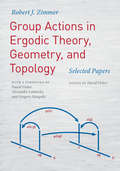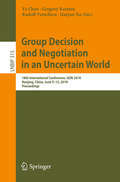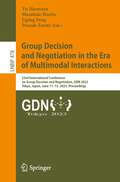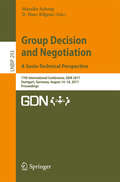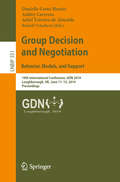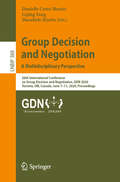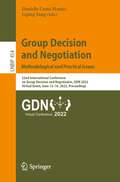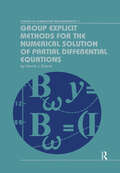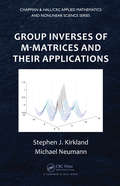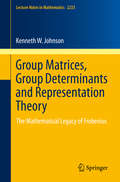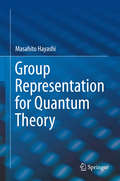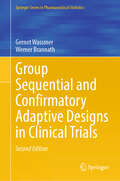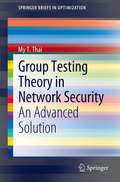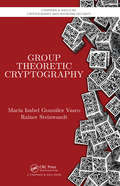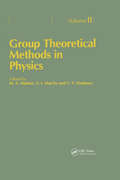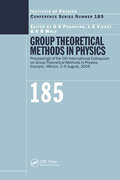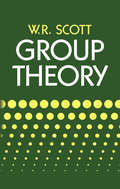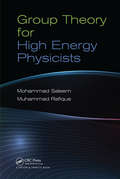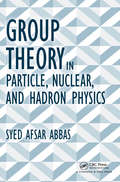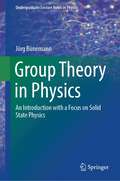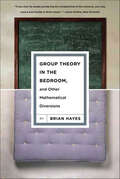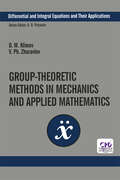- Table View
- List View
Group Actions in Ergodic Theory, Geometry, and Topology: Selected Papers
by Robert J. ZimmerRobert J. Zimmer is best known in mathematics for the highly influential conjectures and program that bear his name. Group Actions in Ergodic Theory, Geometry, and Topology: Selected Papers brings together some of the most significant writings by Zimmer, which lay out his program and contextualize his work over the course of his career. Zimmer’s body of work is remarkable in that it involves methods from a variety of mathematical disciplines, such as Lie theory, differential geometry, ergodic theory and dynamical systems, arithmetic groups, and topology, and at the same time offers a unifying perspective. After arriving at the University of Chicago in 1977, Zimmer extended his earlier research on ergodic group actions to prove his cocycle superrigidity theorem which proved to be a pivotal point in articulating and developing his program. Zimmer’s ideas opened the door to many others, and they continue to be actively employed in many domains related to group actions in ergodic theory, geometry, and topology. In addition to the selected papers themselves, this volume opens with a foreword by David Fisher, Alexander Lubotzky, and Gregory Margulis, as well as a substantial introductory essay by Zimmer recounting the course of his career in mathematics. The volume closes with an afterword by Fisher on the most recent developments around the Zimmer program.
Group Cohomology and Algebraic Cycles
by Burt TotaroGroup cohomology reveals a deep relationship between algebra and topology, and its recent applications have provided important insights into the Hodge conjecture and algebraic geometry more broadly. This book presents a coherent suite of computational tools for the study of group cohomology and algebraic cycles. Early chapters synthesize background material from topology, algebraic geometry, and commutative algebra so readers do not have to form connections between the literatures on their own. Later chapters demonstrate Peter Symonds's influential proof of David Benson's regularity conjecture, offering several new variants and improvements. Complete with concrete examples and computations throughout, and a list of open problems for further study, this book will be valuable to graduate students and researchers in algebraic geometry and related fields.
Group Decision and Negotiation in an Uncertain World: 18th International Conference, GDN 2018, Nanjing, China, June 9-13, 2018, Proceedings (Lecture Notes in Business Information Processing #315)
by Rudolf Vetschera Haiyan Xu Ye Chen Gregory KerstenThis book constitutes the refereed proceedings of the 18th International Conference on Group Decision and Negotiation, GDN 2018, held in Nanjing, China, in June 2018. The field of Group Decision and Negotiation focuses on decision processes with at least two participants and a common goal but conflicting individual goals. Research areas of Group Decision and Negotiation include electronic negotiations, experiments, the role of emotions in group decision and negotiations, preference elicitation and decision support for group decisions and negotiations, and conflict resolution principles.The 15 full papers presented in this volume were carefully reviewed and selected from 143 submissions. They were organized in topical sections named: theoretical concepts of group decision and negotiation; decision support and behavior in group decision and negotiation; and applications of group decision and negotiations.
Group Decision and Negotiation in the Era of Multimodal Interactions: 23rd International Conference on Group Decision and Negotiation, GDN 2023, Tokyo, Japan, June 11–15, 2023, Proceedings (Lecture Notes in Business Information Processing #478)
by Pascale Zaraté Liping Fang Masahide Horita Yu MaemuraThis book constitutes the refereed proceedings of the 23rd International Conference on Group Decision and Negotiation, GDN 2023, which took place in Tokyo, Japan during June 11–15, 2023.The field of Group Decision and Negotiation focuses on decision processes with at least two participants and a common goal but conflicting individual goals. Research areas of Group Decision and Negotiation include electronic negotiations, experiments, the role of emotions in group decision and negotiations, preference elicitation and decision support for group decisions and negotiations, and conflict resolution principles. This year’s conference focusses on multimodal interactions. The 11 full papers presented in this volume were carefully reviewed and selected from 102 submissions. They were organized in the following topical sections: Taking a step back: Critically re-examining technology interactions with group decision and negotiation; preference modeling and multi-criteria decision-making; and conflict modeling and distributive mechanisms.
Group Decision and Negotiation. A Socio-Technical Perspective: 17th International Conference, GDN 2017, Stuttgart, Germany, August 14-18, 2017, Proceedings (Lecture Notes in Business Information Processing #293)
by D. Marc Kilgour Mareike SchoopThis book constitutes the refereed proceedings of the 17th International Conference on Group Decision and Negotiation, GDN 2017, held in Stuttgart, Germany, in August 2017. The field of Group Decision and Negotiation focuses on decision processes with at least two participants and a common goal but conflicting individual goals. Research areas of Group Decision and Negotiation include electronic negotiations, experiments, the role of emotions in group decision and negotiations, preference elicitation and decision support for group decisions and negotiations, and conflict resolution principles.The 14 full papers presented in this volume were carefully reviewed and selected from 87 submissions. They were organized in topical sections named: general topics in group decision and negotiation; conflict resolution; emotions in group decision and negotiation; negotiation support systems and studies; and preference modeling for group decision and negotiation. The book also contains two invited talks in full paper length.
Group Decision and Negotiation: 19th International Conference, GDN 2019, Loughborough, UK, June 11–15, 2019, Proceedings (Lecture Notes in Business Information Processing #351)
by Adiel Teixeira de Almeida Rudolf Vetschera Danielle Costa Morais Ashley CarrerasThis book constitutes the refereed proceedings of the 19th International Conference on Group Decision and Negotiation, GDN 2019, held in Loughborough, UK, in June 2019. The field of Group Decision and Negotiation focuses on decision processes with at least two participants and a common goal but conflicting individual goals. Research areas of Group Decision and Negotiation include electronic negotiations, experiments, the role of emotions in group decision and negotiations, preference elicitation and decision support for group decisions and negotiations, and conflict resolution principles. The 17 full papers presented in this volume were carefully reviewed and selected from 98 submissions. They were organized in topical sections named: preference modeling for group decision and negotiations; collaborative decision making processes; conflict resolution; behavioral OR, and negotiation support systems and studies.
Group Decision and Negotiation: 20th International Conference on Group Decision and Negotiation, GDN 2020, Toronto, ON, Canada, June 7–11, 2020, Proceedings (Lecture Notes in Business Information Processing #388)
by Liping Fang Danielle Costa Morais Masahide HoritaThis book constitutes the refereed proceedings of the 20th International Conference on Group Decision and Negotiation, GDN 2020, which was planned to be held in Toronto, ON, Canada, during June 7–11, 2020. The conference was cancelled due to the Coronavirus pandemic. Nevertheless, it was decided to publish the proceedings, because the review process had already been completed at the time the cancellation was decided. The field of Group Decision and Negotiation focuses on decision processes with at least two participants and a common goal but conflicting individual goals. Research areas of Group Decision and Negotiation include electronic negotiations, experiments, the role of emotions in group decision and negotiations, preference elicitation and decision support for group decisions and negotiations, and conflict resolution principles. The 14 full papers presented in this volume were carefully reviewed and selected from 75 submissions. They were organized in topical sections named: Conflict Resolution, Preference Modeling for Group Decision and Negotiation, Intelligent Group Decision Making and Consensus Process, Collaborative Decision Making Processes.
Group Decision and Negotiation: 22nd International Conference on Group Decision and Negotiation, GDN 2022, Virtual Event, June 12–16, 2022, Proceedings (Lecture Notes in Business Information Processing #454)
by Liping Fang Danielle Costa MoraisThis book constitutes the refereed proceedings of the 22nd International Conference on Group Decision and Negotiation, GDN 2022, which was held virtually during June 12–16, 2022. The field of Group Decision and Negotiation focuses on decision processes with at least two participants and a common goal but conflicting individual goals. Research areas of Group Decision and Negotiation include electronic negotiations, experiments, the role of emotions in group decision and negotiations, preference elicitation and decision support for group decisions and negotiations, and conflict resolution principles. This year’s conference focusses on methodological and practical issues. The 9 full papers presented in this volume were carefully reviewed and selected from 68 submissions. They were organized in the following topical sections: Preference modeling for group decision and negotiation; conflict resolution; collaborative decision making processes.
Group Explicit Methods for the Numerical Solution of Partial Differential Equations (Topics in Computer Mathematics)
by David J. EvansA new class of methods, termed "group explicit methods," is introduced in this text. Their applications to solve parabolic, hyperbolic and elliptic equations are outlined, and the advantages for their implementation on parallel computers clearly portrayed. Also included are the introductory and fundamental concepts from which the new methods are derived, and on which they are dependent. With the increasing advent of parallel computing into all aspects of computational mathematics, there is no doubt that the new methods will be widely used.
Group Inverses of M-Matrices and Their Applications
by Stephen J. Kirkland Michael NeumannGroup inverses for singular M-matrices are useful tools not only in matrix analysis, but also in the analysis of stochastic processes, graph theory, electrical networks, and demographic models. Group Inverses of M-Matrices and Their Applications highlights the importance and utility of the group inverses of M-matrices in several application areas.
Group Matrices, Group Determinants and Representation Theory: The Mathematical Legacy of Frobenius (Lecture Notes in Mathematics #2233)
by Kenneth W. JohnsonThis book sets out an account of the tools which Frobenius used to discover representation theory for nonabelian groups and describes its modern applications. It provides a new viewpoint from which one can examine various aspects of representation theory and areas of application, such as probability theory and harmonic analysis. For example, the focal objects of this book, group matrices, can be thought of as a generalization of the circulant matrices which are behind many important algorithms in information science. The book is designed to appeal to several audiences, primarily mathematicians working either in group representation theory or in areas of mathematics where representation theory is involved. Parts of it may be used to introduce undergraduates to representation theory by studying the appealing pattern structure of group matrices. It is also intended to attract readers who are curious about ideas close to the heart of group representation theory, which do not usually appear in modern accounts, but which offer new perspectives.
Group Representation for Quantum Theory
by Masahito HayashiThis book explains the group representation theory for quantum theory in the language of quantum theory. As is well known, group representation theory is very strong tool for quantum theory, in particular, angular momentum, hydrogen-type Hamiltonian, spin-orbit interaction, quark model, quantum optics, and quantum information processing including quantum error correction. To describe a big picture of application of representation theory to quantum theory, the book needs to contain the following six topics, permutation group, SU(2) and SU(d), Heisenberg representation, squeezing operation, Discrete Heisenberg representation, and the relation with Fourier transform from a unified viewpoint by including projective representation. Unfortunately, although there are so many good mathematical books for a part of six topics, no book contains all of these topics because they are too segmentalized. Further, some of them are written in an abstract way in mathematical style and, often, the materials are too segmented. At least, the notation is not familiar to people working with quantum theory. Others are good elementary books, but do not deal with topics related to quantum theory. In particular, such elementary books do not cover projective representation, which is more important in quantum theory. On the other hand, there are several books for physicists. However, these books are too simple and lack the detailed discussion. Hence, they are not useful for advanced study even in physics. To resolve this issue, this book starts with the basic mathematics for quantum theory. Then, it introduces the basics of group representation and discusses the case of the finite groups, the symmetric group, e. g. Next, this book discusses Lie group and Lie algebra. This part starts with the basics knowledge, and proceeds to the special groups, e. g. , SU(2), SU(1,1), and SU(d). After the special groups, it explains concrete applications to physical systems, e. g. , angular momentum, hydrogen-type Hamiltonian, spin-orbit interaction, and quark model. Then, it proceeds to the general theory for Lie group and Lie algebra. Using this knowledge, this book explains the Bosonic system, which has the symmetries of Heisenberg group and the squeezing symmetry by SL(2,R) and Sp(2n,R). Finally, as the discrete version, this book treats the discrete Heisenberg representation which is related to quantum error correction. To enhance readers' undersnding, this book contains 54 figures, 23 tables, and 111 exercises with solutions.
Group Sequential and Confirmatory Adaptive Designs in Clinical Trials (Springer Series in Pharmaceutical Statistics)
by Gernot Wassmer Werner BrannathThis book provides an up-to-date review of the general principles and techniques of confirmatory adaptive designs, a generalization of group sequential designs. With these designs, interim analyses are performed in order to stop a trial prematurely under control of the Type I error rate. In adaptive designs, it is also permissible to perform a data-driven change of relevant aspects of the study design at interim stages. This includes, for example, a sample-size reassessment, a treatment-arm selection, or a selection of a pre-specified sub-population.First introduced in the 1990s, this popular adaptive methodology has become the focus of intense discussion and is still a rapidly growing field of statistical research. The book describes adaptive design methodology at an elementary level, while also considering design and planning issues. It also looks at methods for analyzing an adaptively planned trial, such as estimation methods and methods for determining an overall p-value. Part I provides the group sequential preliminaries required to understand and apply the adaptive design methodology supplied in Parts II and III. Many examples are included that illustrate the practical applications of the techniques. An overview of recent developments is given and, new to this edition, detailed descriptions of the R commands used for the calculations are provided. The R package rpact, which is available on CRAN, allows for the recalculation of most tables and results presented in the monograph. The required knowledge of R has been kept to a minimum, and an online Shiny app has been made available for rpact. Primarily written for applied statisticians from academia and industry who are interested in confirmatory adaptive designs, the text is also suitable for an advanced statistical course for applied statisticians or clinicians with a sound statistical background.
Group Testing Theory in Network Security
by My T. ThaiGroup Testing Theory in Network Security explores a new branch of group testing theory with an application which enhances research results in network security. This brief presents new solutions on several advanced network security problems and mathematical frameworks based on the group testing theory, specifically denial-of-service and jamming attacks. A new application of group testing, illustrated in this text, requires additional theories, such as size constraint group testing and connected group testing. Included in this text is a chapter devoted to discussing open problems and suggesting new solutions for various network security problems. This text also exemplifies the connection between mathematical approaches and practical applications to group testing theory in network security. This work will appeal to a multidisciplinary audience with interests in computer communication networks, optimization, and engineering.
Group Theoretic Cryptography (Chapman & Hall/CRC Cryptography and Network Security Series)
by Maria Isabel Gonzalez Vasco Rainer SteinwandtGroup theory appears to be a promising source of hard computational problems for deploying new cryptographic constructions. This reference focuses on the specifics of using groups, including in particular non-Abelian groups, in the field of cryptography. It provides an introduction to cryptography with emphasis on the group theoretic perspective, making it one of the first books to use this approach. The authors provide the needed cryptographic and group theoretic concepts, full proofs of essential theorems, and formal security evaluations of the cryptographic schemes presented. They also provide references for further reading and exercises at the end of each chapter.
Group Theoretical Methods in Physics. Volume II: Proceedings of the Third Yurmala Seminar, Yurmala, USSR, 22-24 May 1985
by M. A. Markov V. I. Man'Ko V. V. DodonovThese Proceedings cover various topics in modern physics in which group theoretical methods can be applied effectively. The two volumes, containing over 100 papers, cover such areas as representation theory, the theory and applications of dynamical symmetries and coherent states, symmetries in atomic, molecular, nuclear and elementary particle physics, field theory including gauge theories, supersymmetry and supergravity, general relativity and cosmology, the theory of space groups and its applications to solid state physics and phase transitions, the problems of quantum and classical mechanics and paraxial optics, and the theory of nonlinear equations and solitons.
Group Theoretical Methods in Physics: Proceedings of the XXV International Colloqium on Group Theoretical Methods in Physics, Cocoyoc, Mexico, 2-6 August, 2004 (Institute of Physics Conference Series)
by George S. Pogosyan, Luis Edgar Vicent and Kurt Bernardo WolfThis book discusses group theoretical methods and their applications in physics, chemistry, and biology. It covers traditional subjects including Lie group and representation theory, special functions, foundations of quantum mechanics, and elementary particle, nuclear, atomic, and molecular physics. More recent areas discussed are supersymmetry, superstrings and quantum gravity, integrability, nonlinear systems and quantum chaos, semigroups, time asymmetry and resonances, condensed matter, and statistical physics. Topics such as linear and nonlinear optics, quantum computing, discrete systems, and signal analysis have only in the last few years become part of the group theorists' turf.
Group Theory
by Pierre RamondGroup theory has long been an important computational tool for physicists, but, with the advent of the Standard Model, it has become a powerful conceptual tool as well. This book introduces physicists to many of the fascinating mathematical aspects of group theory, and mathematicians to its physics applications. Designed for advanced undergraduate and graduate students, this book gives a comprehensive overview of the main aspects of both finite and continuous group theory, with an emphasis on applications to fundamental physics. Finite groups are extensively discussed, highlighting their irreducible representations and invariants. Lie algebras, and to a lesser extent Kac-Moody algebras, are treated in detail, including Dynkin diagrams. Special emphasis is given to their representations and embeddings. The group theory underlying the Standard Model is discussed, along with its importance in model building. Applications of group theory to the classification of elementary particles are treated in detail.
Group Theory (Dover Books on Mathematics)
by W. R. ScottWell-organized and clearly written, this undergraduate-level text covers most of the standard basic theorems in group theory, providing proofs of the basic theorems of both finite and infinite groups and developing as much of their superstructure as space permits. Contents include: Isomorphism Theorems, Direct Sums, p-Groups and p-Subgroups, Free Groups and Free Products, Permutation Groups, Transformations and Subgroups, Abelian Groups, Supersolvable Groups, Extensions, Representations, and more. The concluding chapters also cover a wide variety of further theorems, some not previously published in book form, including infinite symmetric and alternating groups, products of subgroups, the multiplicative group of a division ring, and FC groups.Over 500 exercises in varying degrees of difficulty enable students to test their grasp of the material, which is largely self-contained (except for later chapters which presuppose some knowledge of linear algebra, polynomials, algebraic integers, and elementary number theory). Also included are a bibliography, index, and an index of notation. Ideal as a text or for reference, this inexpensive paperbound edition of Group Theory offers mathematics students a lucid, highly useful introduction to an increasingly vital mathematical discipline. It will be welcomed by anyone in search of a cogent, thorough presentation that lends itself equally well to self-study or regular course work.
Group Theory I Essentials
by Emil MilewskiREA's Essentials provide quick and easy access to critical information in a variety of different fields, ranging from the most basic to the most advanced. As its name implies, these concise, comprehensive study guides summarize the essentials of the field covered. Essentials are helpful when preparing for exams, doing homework and will remain a lasting reference source for students, teachers, and professionals. Group Theory I includes sets and mapping, groupoids and semi-groups, groups, isomorphisms and homomorphisms, cyclic groups, the Sylow theorems, and finite p-groups.
Group Theory for High Energy Physicists
by Mohammad Saleem Muhammad RafiqueAlthough group theory has played a significant role in the development of various disciplines of physics, there are few recent books that start from the beginning and then build on to consider applications of group theory from the point of view of high energy physicists. Group Theory for High Energy Physicists fills that role. It presents groups, e
Group Theory in Particle, Nuclear, and Hadron Physics
by Syed Afsar AbbasThis user-friendly book on group theory introduces topics in as simple a manner as possible and then gradually develops those topics into more advanced ones, eventually building up to the current state-of-the-art. By using simple examples from physics and mathematics, the advanced topics become logical extensions of ideas already introduced. In addition to being used as a textbook, this book would also be useful as a reference guide for graduates and researchers in particle, nuclear and hadron physics.
Group Theory in Physics: An Introduction with a Focus on Solid State Physics (Undergraduate Lecture Notes in Physics)
by Jörg BünemannThis textbook provides a didactic introduction to the topic of group theory in physics, with a special focus on solid state physics issues. The book is useful for students who encounter such problems in their first scientific work (in theory or experiment). In addition to the basic introduction to group theory and representation theory, the book deals with point groups, double point groups, and space groups, which are essential in solid state physics. As an example for systems with space group symmetry, electrons in periodic potentials are discussed. Furthermore, there are chapters on material tensors and the Wigner Eckart theorem for the evaluation of matrix elements. The latter is especially interesting for students dealing with spectroscopic problems. The content is accompanied by a series of exercises and examples. A set of solutions can be found in the appendix.
Group Theory in the Bedroom, and Other Mathematical Diversions
by Brian HayesAn Award-Winning Essayist Plies His CraftBrian Hayes is one of the most accomplished essayists active today—a claim supported not only by his prolific and continuing high-quality output but also by such honors as the National Magazine Award for his commemorative Y2K essay titled "Clock of Ages," published in the November/December 1999 issue of The Sciences magazine. (The also-rans that year included Tom Wolfe, Verlyn Klinkenborg, and Oliver Sacks.) Hayes's work in this genre has also appeared in such anthologies as The BestAmerican Magazine Writing, The Best American Science and NatureWriting, and The Norton Reader. Here he offers us a selection of his most memorable and accessible pieces—including "Clock of Ages"—embellishing them with an overall, scene-setting preface, reconfigured illustrations, and a refreshingly self-critical "Afterthoughts" section appended to each essay.
Group-Theoretic Methods in Mechanics and Applied Mathematics
by D.M. KlimovGroup analysis of differential equations has applications to various problems in nonlinear mechanics and physics. Group-Theoretic Methods in Mechanics and Applied Mathematics systematizes the group analysis of the main postulates of classical and relativistic mechanics. Exact solutions are given for the following equations: dynamics of rigid body, heat transfer, wave, hydrodynamics, Thomas-Fermi, and more. The author pays particular attention to the application of group analysis to developing asymptotic methods for problems with small parameters. This book is designed for a broad audience of scientists, engineers, and students in the fields of applied mathematics, mechanics and physics.
